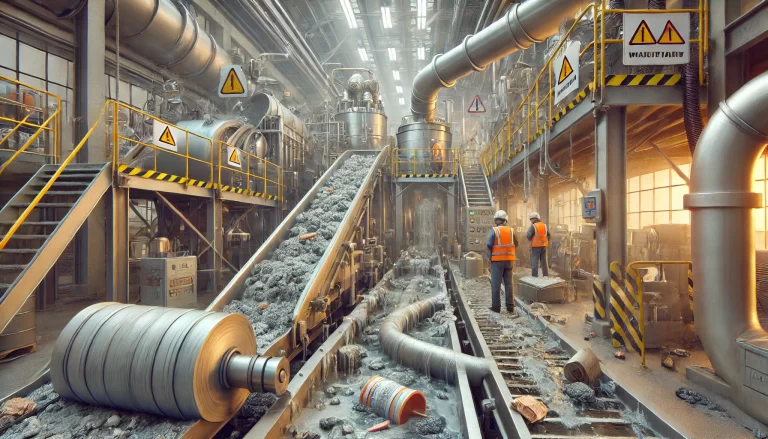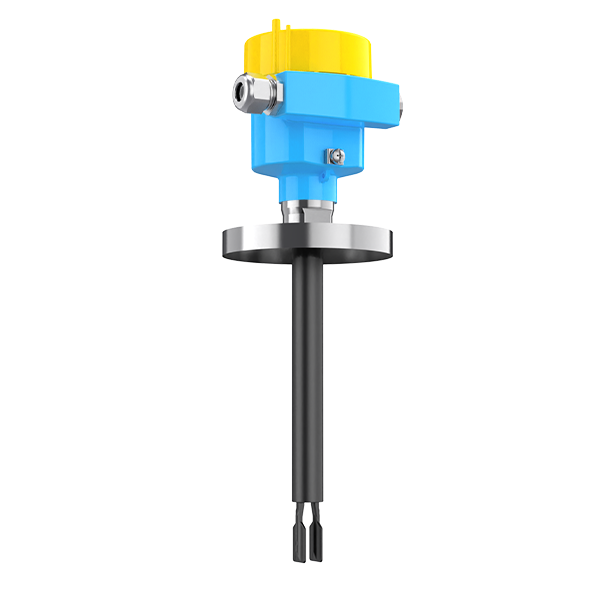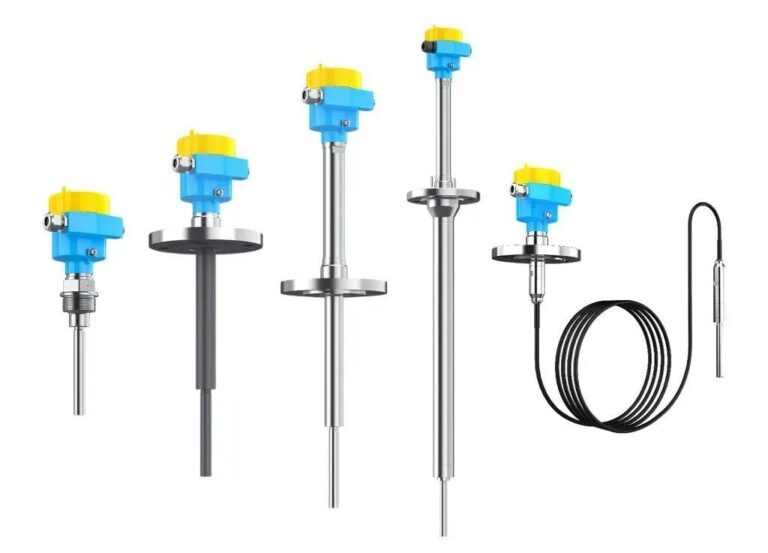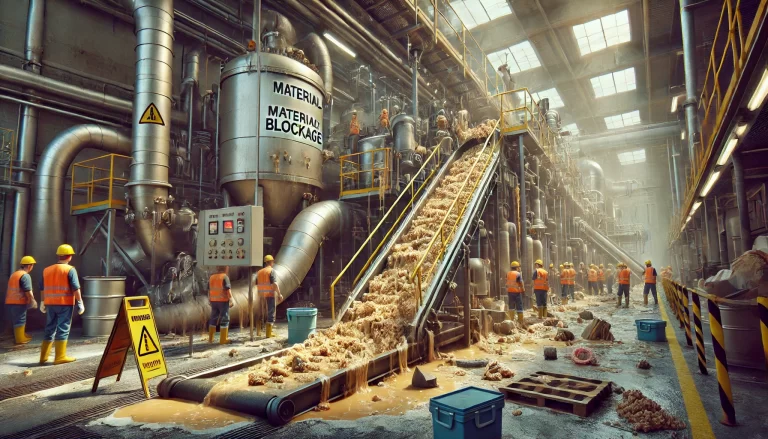1. Introduction
Material flow issues such as jamming, clogging, and material adhesion are common problems in industrial production. These issues can significantly impact production efficiency, cause equipment damage, and increase downtime. Therefore, understanding their causes, consequences, and potential solutions is crucial for maintaining a stable and efficient production process.

2. Definitions and Key Differences
2.1 Jamming (Material Stagnation)
Jamming occurs when materials become lodged within equipment or pipelines, preventing normal movement and processing. It is commonly seen in conveyor systems, crushers, and granular material transport mechanisms. Key causes of jamming include:
Oversized Material Particles: Large or irregularly shaped particles can obstruct the flow within processing equipment.
High Material Moisture Content: Excess moisture can cause materials to clump together, restricting movement.
Excessive Material Hardness: Hard or brittle materials may accumulate and cause blockages, particularly in crushing equipment.
2.2 Clogging (Complete Obstruction)
Clogging refers to the complete blockage of material flow, often occurring in pipelines, ducts, and sieves. Unlike jamming, clogging typically results in the total failure of material transport. The primary causes of clogging include:
High Material Viscosity: Sticky materials tend to adhere to pipe walls, forming obstructions.
Fine Particles or Uneven Distribution: Small particles may accumulate within a conduit, eventually creating a dense blockage.
Poor Pipeline Design: Narrow internal diameters, excessive bends, and inadequate flow rates increase clogging risks.
Temperature and Humidity Variations: Changes in environmental conditions may alter material properties, leading to reduced flowability.
2.3 Material Adhesion (Hanging Material)
Material adhesion, or hanging material, occurs when materials stick to equipment surfaces, forming deposits that impede flow. This issue is prevalent in vibrating screens, conveyor belts, and pelletizing machines, especially when handling high-moisture or sticky materials. The primary causes include:
Excessive Moisture: Damp materials tend to stick to equipment surfaces, leading to buildup and blockages.
Irregular Material Shapes: Elongated or needle-shaped particles may interlock, preventing smooth movement.
Inadequate Equipment Vibration: Low vibration frequency in screens and conveyors can allow materials to accumulate rather than flow freely.

3. Root Cause Analysis of Material Flow Issues
3.1 Causes of Jamming
Material Properties: Hard, oversized, or irregularly shaped materials increase the likelihood of jamming.
Equipment Design Flaws: Narrow passages, sharp turns, and inefficient flow channels contribute to blockages.
Operational Mistakes: Overloading, inconsistent material feeding, and improper handling practices exacerbate jamming.
3.2 Causes of Clogging
Sticky or Cohesive Materials: High-viscosity materials adhere to surfaces, reducing flow rates and causing blockages.
Poor Particle Size Distribution: Excessive fines may compact and block passageways.
Pipeline Design Issues: Small pipe diameters, unnecessary bends, and slow flow rates hinder material transport.
Environmental Factors: Temperature shifts and high humidity can alter material behavior, leading to unexpected blockages.
3.3 Causes of Material Adhesion
High Humidity Levels: Moisture promotes adhesion, leading to material buildup.
Poor Equipment Surface Design: Rough or porous surfaces facilitate material sticking.
Insufficient Mechanical Agitation: Low-frequency vibrations or ineffective cleaning mechanisms allow material deposits to form.

4. Case Studies of Common Industrial Issues
Case Study 1: Jamming in a Fertilizer Production Facility
A fertilizer plant frequently experienced jamming in its granular material transport system, particularly when handling high-moisture raw materials. Investigation revealed that excessive bends in the transport pipes were causing material accumulation. The solution involved redesigning the pipeline layout to minimize sharp turns and increasing vibration-assisted flow mechanisms. This significantly reduced jamming incidents and improved production stability.
Case Study 2: Clogging in a Pharmaceutical Powder Transport System
A pharmaceutical company faced repeated clogging in its powder transport system, leading to production delays. The root cause was identified as undersized pipelines with multiple sharp bends and inefficient filtration screens. The company resolved the issue by increasing pipe diameter, optimizing filter placement, and adjusting flow speed, thereby eliminating recurrent clogging.
Case Study 3: Material Adhesion in a Food Processing Plant
A food processing facility encountered persistent material adhesion issues in its drying equipment, particularly during humid seasons. The primary cause was identified as excessive moisture in the raw material and inadequate vibration settings in the drying unit. The plant successfully mitigated the problem by installing additional dehumidification systems and increasing vibration frequency, ensuring uninterrupted production.

5. Solutions and Best Practices
5.1 Optimizing Equipment Design
Ensure Proper Flow Channel Dimensions: Avoid excessive narrowing and abrupt turns.
Choose Suitable Equipment for Specific Materials: Use specialized machinery for handling high-moisture and sticky materials.
5.2 Improving Operational Practices
Ensure Even Material Distribution: Prevent overloading and feed materials consistently.
Monitor Equipment Performance: Regularly check for early signs of material buildup or inefficiencies.
5.3 Material Handling and Conditioning
Control Moisture and Adhesion Properties: Use drying agents or anti-clogging additives when necessary.
Adjust Processing Conditions: Optimize temperature and humidity levels to improve material flow.
5.4 Preventative Maintenance and Regular Inspections
Conduct Routine Equipment Checks: Identify early signs of wear, tear, or material buildup.
Implement Cleaning Protocols: Regularly clean critical components to prevent obstructions.

6. Conclusion
Jamming, clogging, and material adhesion are common industrial challenges that can negatively impact efficiency and equipment lifespan. By understanding the root causes and implementing strategic solutions—such as optimizing equipment design, improving operational procedures, and conducting preventative maintenance—manufacturers can significantly reduce material flow issues and enhance overall productivity.
To achieve long-term operational stability, companies should tailor their solutions based on material characteristics, production conditions, and equipment specifications, ensuring smooth and efficient industrial processes.
